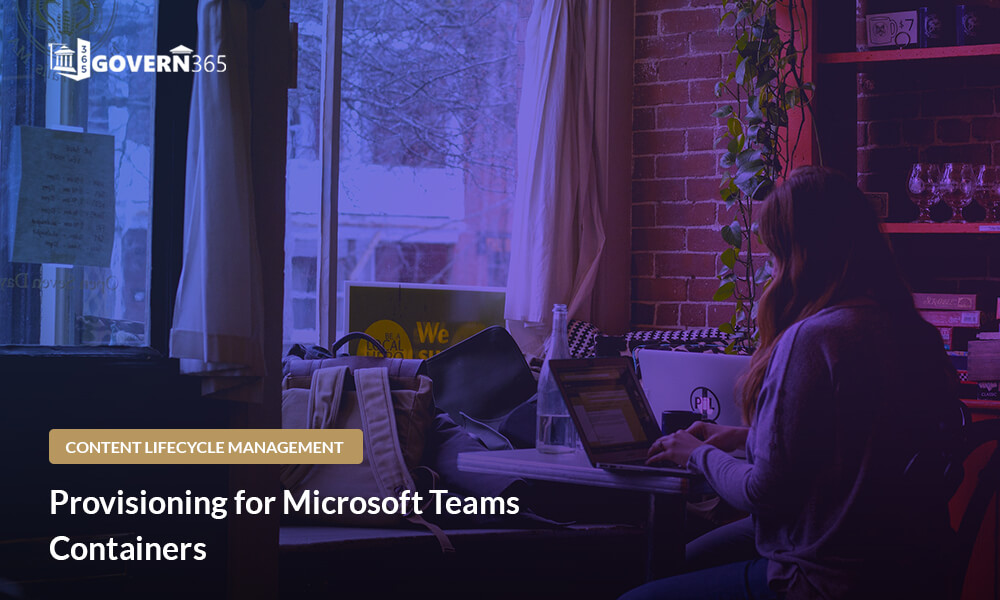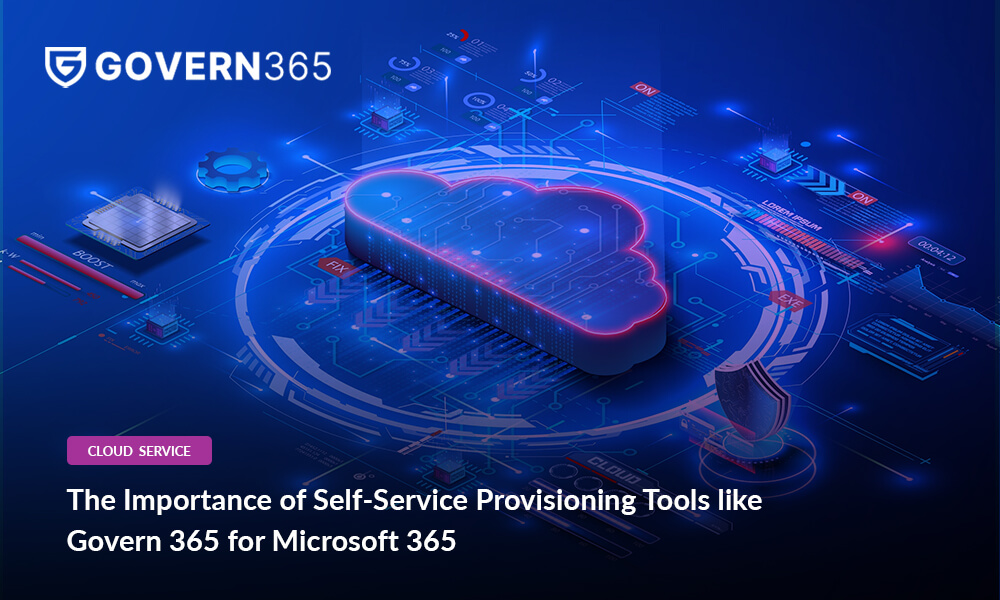STAY CONNECTED
EXPLORE MORE
- Compliance (7)
- Data Room (29)
- Life Science (2)
- Mergers & Acquisition (1)
- News (1)
- Secure Collaboration (9)
- Self Provisioning (3)
- Uncategorized (1)
Introduction
It is said that Microsoft tends to do well on version 3 of everything! This is not a poke at Microsoft, it is more the nature of software lifecycle. Software improves as and when its creators embody the flexibility to understand the intersection point between their vision and the market’s response to using their product. Given the Microsoft 365 ecosystem today, we now have a complete and secure content & collaboration platform that can be scaled to about any desired size.
However, this does not mean that the platform is free of challenges. One of the most prominent struggles that we regularly hear about is that Microsoft 365 users see too many options. They see Yammer. They see Groups. They see Teams. They see Planner. They see Communication Sites. They see Team Sites. The list goes on… and unfortunately, most users are not going to spend the time it takes to really understand the nuances between these workloads on their own accord. Add to that the buzzword of “self-service” without adding to the life cycle management challenges and not imposing any burden on IT.
You could also be faced with user level questions that would simply need a PhD! in Microsoft Products to answer. Consider the following as samples.
- Should I use Groups instead of team sites?
- SharePoint security groups and Microsoft 365 groups- are they completely different?
- Can a Team Site member easily broadcast an email to all of the team members?
- Should I use Groups or MS Teams in order to share a file/folder with an external user?
In all likelihood, the business users don’t know the answers with all the implications.
Now let’s consider what IT might think. IT always would like to have things under control but at the same time they also want to be able to let the business do what is easiest for them to get their work done in a fast and intuitive way. The intrinsic trouble is users will create whatever they need to get their work done, but they may not be able to find it later and will never clean it up. So, as IT admin, it becomes a bit more concerning for content lifecycle management and possibly for other governance areas.
At Netwoven, Microsoft technology is in our DNA for last 20 years and we thought of creating a governance layer in the name of “Govern 365” for the IT admin enabling end users to provision their containers through a dynamically created intuitive user interface without sacrificing governance and compliance requirements.
Unlocking the Potential of Govern 365 for Ground-Level Organizational Success
So, what exactly it is that Govern 365 has to offer to an organization on the ground?
To start with, it offers a self-servicing facility to the business users enabling them to create the containers that they need to support their workload by simply answering few business questions about the intended usage and more so, it is only defined and enabled by IT admin.
Seeing is believing; let’s see how Govern 365 works and makes the self-servicing of users a reality without risk, admin overhead and content sprawl. However, it isn’t restrictive at all. If you are a knowledgeable user (just short of having a PhD in Microsoft technologies), you can bypass the wizard and directly choose your desired container, specify the minimal operational parameters and be happy with your provisioning getting done automatically.
Let’s look at a sample wizard driven process. You may choose to submit a new provisioning request after logging in and you will be presented with the screen below.
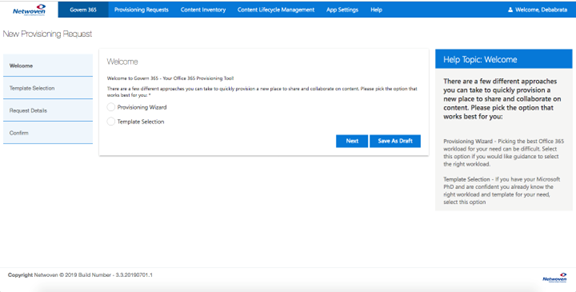
It presents two clear options to the user, either to take a direct route for choosing a template if one is sure about it or just take help from the wizard and be guided appropriately. Choose provisioning wizard and see the screen below.
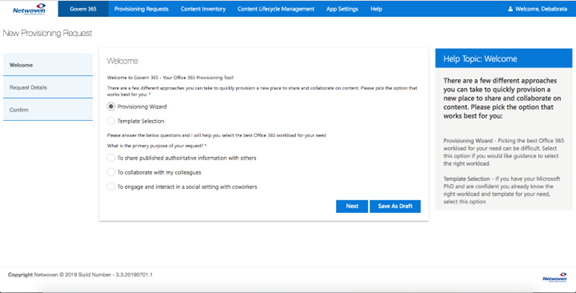
Note that the on-screen text for each option is self-explanatory but clearly helps you to intuitively decide on your workload. Supposing your requirement currently is to be able to collaborate with your colleague and you make that choice, you will further be prompted to choose a conversational medium e.g. e-mail or chat.
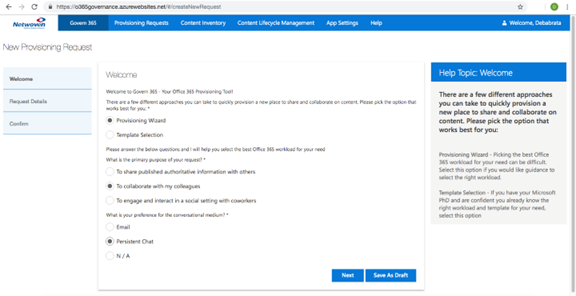
Once you have made your choice (e.g. persistent chat) and moved on to “Next”, the wizard will present you with a screen as given below with many parameters auto-populated based on your intended usage so as to make your job easy.
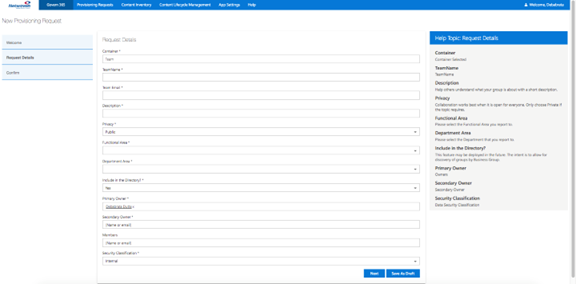
The interesting thing to note is that the wizard has determined that a “Teams” container would be most appropriate for you in this example. It could as well have decided that the container should be something else e.g. Microsoft 365 group or communication site etc had you chosen different options while making your selections. Also, it asks you for only a few relevant parameters and all other internal attributes are automatically defaulted. This helps you in two major ways, one, it takes the very decision regarding which workload would satisfy your requirement best and the other saving you from specifying a host of parameters which you would have to do if you were using the native admin center of Microsoft 365.
Beyond this, you will only have to confirm your choices and the provisioning engine of Govern 365 would take over. It will queue your request, service it as soon as possible undertaking all internal validations and finally would mail you back the link to the just provisioned container. You are done with all the complex system tasks to get you onboard and you are in full steam to get going with your business as usual.
Conclusion
Finally, the wizardry didn’t begin with the form and the guided process that you experienced. It began much earlier when your admin created the customized form for you using the configuration utility inbuilt within Govern 365. Any kind of provisioning request form can be designed using the exhaustive field controls that are provided in the utility. Your provisioning experience is not just tailor-made for you it can always be tailor-made for all.
